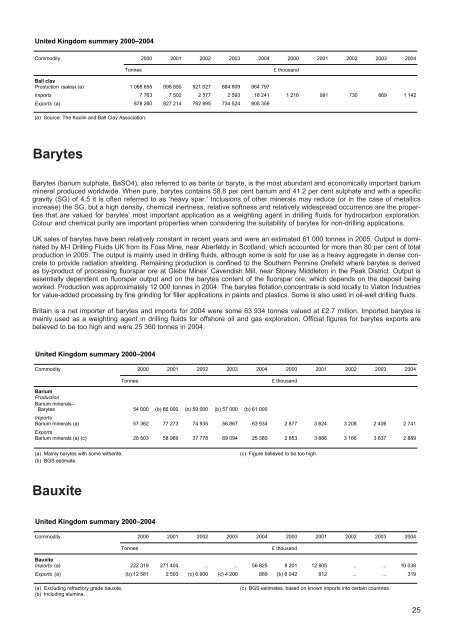Create successful ePaper yourself
Turn your PDF publications into a flip-book with our unique Google optimized e-Paper software.
united Kingdom summary 2000–2004<br />
Commodity 2000 2001 2002 2003 2004 2000 2001 2002 2003 2004<br />
Tonnes £ thousand<br />
ball clay<br />
Production (sales) (a) 1 068 655 998 850 921 027 884 809 964 797<br />
Imports 7 763 7 502 2 577 2 593 18 241 1 216 991 730 669 1 142<br />
Exports (a) 878 260 827 214 762 895 734 524 805 359<br />
(a) Source: The Kaolin and Ball Clay Association.<br />
barytes<br />
Barytes (barium sulphate, BaSO4), also referred to as barite or baryte, is the most abundant and economically important barium<br />
mineral produced worldwide. When pure, barytes contains 58.8 per cent barium and 41.2 per cent sulphate and with a specific<br />
gravity (SG) of 4.5 it is often referred to as ‘heavy spar.’ Inclusions of other minerals may reduce (or in the case of metallics<br />
increase) the SG, but a high density, chemical inertness, relative softness and relatively widespread occurrence are the properties<br />
that are valued for barytes’ most important application as a weighting agent in drilling fluids for hydrocarbon exploration.<br />
Colour and chemical purity are important properties when considering the suitability of barytes for non-drilling applications.<br />
UK sales of barytes have been relatively constant in recent years and were an estimated 61 000 tonnes in 2005. Output is dominated<br />
by M-I Drilling Fluids UK from its Foss Mine, near Aberfeldy in Scotland, which accounted for more than 80 per cent of total<br />
production in 2005. The output is mainly used in drilling fluids, although some is sold for use as a heavy aggregate in dense concrete<br />
to provide radiation shielding. Remaining production is confined to the Southern Pennine Orefield where barytes is derived<br />
as by-product of processing fluorspar ore at Glebe Mines’ Cavendish Mill, near Stoney Middleton in the Peak District. Output is<br />
essentially dependent on fluorspar output and on the barytes content of the fluorspar ore, which depends on the deposit being<br />
worked. Production was approximately 12 000 tonnes in 2004. The barytes flotation concentrate is sold locally to Viaton Industries<br />
for value-added processing by fine grinding for filler applications in paints and plastics. Some is also used in oil-well drilling fluids.<br />
Britain is a net importer of barytes and imports for 2004 were some 63 934 tonnes valued at £2.7 million. Imported barytes is<br />
mainly used as a weighting agent in drilling fluids for offshore oil and gas exploration. Official figures for barytes exports are<br />
believed to be too high and were 25 360 tonnes in 2004.<br />
united Kingdom summary 2000–2004<br />
Commodity 2000 2001 2002 2003 2004 2000 2001 2002 2003 2004<br />
Tonnes £ thousand<br />
barium<br />
Production<br />
Barium minerals–<br />
Barytes 54 000 (b) 66 000 (b) 59 000 (b) 57 000 (b) 61 000<br />
Imports<br />
Barium minerals (a) 57 362 77 273 74 935 56 867 63 934 2 877 3 624 3 208 2 406 2 741<br />
Exports<br />
Barium minerals (a) (c) 28 503 58 969 37 778 69 094 25 360 2 853 3 886 3 166 3 837 2 889<br />
(a) Mainly barytes with some witherite. (c) Figure believed to be too high.<br />
(b) BGS estimate.<br />
bauxite<br />
united Kingdom summary 2000–2004<br />
Commodity 2000 2001 2002 2003 2004 2000 2001 2002 2003 2004<br />
Tonnes £ thousand<br />
bauxite<br />
Imports (a) 222 319 271 404 ... ... 56 825 8 201 12 805 ... ... 10 038<br />
Exports (a) (b) 12 581 2 593 (c) 6 900 (c) 4 200 889 (b) 6 042 912 ... ... 319<br />
(a) Excluding refractory grade bauxite. (c) BGS estimates, based on known imports into certain countries.<br />
(b) Including alumina.<br />
25

















